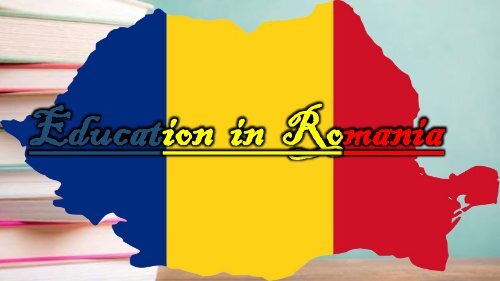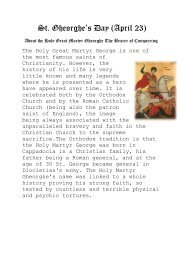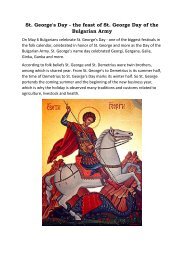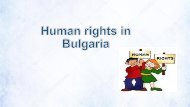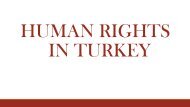sistem educational
You also want an ePaper? Increase the reach of your titles
YUMPU automatically turns print PDFs into web optimized ePapers that Google loves.
Education in Romania
Introduction<br />
Romania’s current education system is relatively new. Under<br />
communism, education in Romania was politically-fueled. The<br />
communist revolution in eastern Europe heavily influenced a<br />
nationalistic approach to education in Romania.<br />
Education is regulated and enforced by the Ministry of National<br />
Education. Each step has its own form of organization and is subject<br />
to different laws and directives. Since the downfall of the communist<br />
regime, the Romanian <strong>educational</strong> system has been through several<br />
reforms.
Kindergarden<br />
Kindergardens offer<br />
preschool education for<br />
children (usually between<br />
ages 3–6) and are optional.<br />
Kindergarden typically lasts<br />
for 3 forms – "small group"<br />
(grupa mică) for children<br />
aged 3–4, "middle group"<br />
(grupa mijlocie), for children<br />
aged 4–5, and "big group"<br />
(grupa mare) for children<br />
aged 5–6.
Kindergarden services differ from one<br />
kindergarden to another, and from public (state) to<br />
private ones, and may include initiation in foreign<br />
languages (typically English, French or German),<br />
introduction in computer studies, dancing,<br />
swimming, etc.<br />
All kindergardens provide at least one meal or one<br />
snack, some having their own kitchen and their<br />
own cooks. Many kindergardens (especially the<br />
private ones) provide children with transportation<br />
to and from the kindergarten. Groups typically<br />
have 1–2 teachers and 10–15 children (typically<br />
more in state kindergartens).
Primary school<br />
Primary school starts with grade 0, or<br />
the preparatory year, which develops the<br />
children's reading and writing skills. The<br />
school calendar is the same in all the<br />
country, and it runs for 35 weeks, roughly<br />
from September 15 to June 15.<br />
For grades 0-4 there is a single teacher<br />
(either a man or a woman), who teaches all<br />
subjects. The primary school curriculum is<br />
focused on Romanian language, math,<br />
sciences and foreign languages.
For instance, a 4th grade student ( 10–<br />
11 years of age) may have on a weekly<br />
basis:<br />
• 4 classes of Math;<br />
• 4–5 classes of Romanian Language<br />
and Literature;<br />
• 1 class of History;<br />
• 1 class of Geography;<br />
• 1–2 classes of Science;<br />
• 2 classes of Art (Painting and<br />
Handcrafting);<br />
• 1–3 classes of a foreign language<br />
(usually French, English or German);
• 1–2 classes of Introduction to<br />
Computers;<br />
• 1 class of Civic Education (a<br />
subject teaching everything from<br />
personal hygiene to the<br />
Constitution and manners in<br />
society);<br />
• 1 class of Religion;<br />
• 1 class of Music Education;<br />
• 2 classes of Physical Education.<br />
• 1 class of an optional subject
Secondary school<br />
There is no entrance exam<br />
to secondary school, and it is<br />
usually continued at the same<br />
institution that provides the<br />
primary education.<br />
Subjects are taught by different<br />
teachers.<br />
A regular school week has<br />
between 26-32 hours of<br />
schooling, in groups of about 25<br />
students. Furthermore, each<br />
class has a teacher designated to<br />
be class principal teacher,<br />
besides teaching his or hers<br />
usual subject.
The curriculum is focused on<br />
mathematics and Romanian language and<br />
literature, and also includes science, social<br />
studies, foreign languages, technology and<br />
art.<br />
The 8th grade marks the last year of<br />
secondary school, and at the end the pupils<br />
need to pass an Assessment Exam<br />
(Evaluarea Națională), on two subjects:<br />
Romanian language and Literature, and<br />
Mathematics. The final grade at the<br />
assessment exam and the average grades<br />
during the secondary school are used for the<br />
acceptance into high-school.
High Schools
Admission
The passing mark is 5 for each. The<br />
admission grade is calculated by taking<br />
into account 20% of all the Yearly<br />
General Averages starting with year 5,<br />
the rest of 80% being the National Test<br />
grade. If the admission grade is lower<br />
than 5 than students choose from a<br />
variety of vocational schools with it`s<br />
main studies being Crafts and Trades.<br />
MA=a student`s admission average<br />
ABS=a student`s final average from V-VIII<br />
classes<br />
EN=a student`s National Testing average<br />
Agricultural<br />
High School<br />
Oravita<br />
(Arts and<br />
Crafts<br />
School)<br />
====>
High School types<br />
There are five types of high schools in Romania<br />
allowing access to university, based on the type of<br />
education offered and their academic<br />
performance. All of these allow for a high school<br />
diploma, access to the BAC exam and therefore<br />
access to university studies.<br />
The choice of high school profile and<br />
specialization does not limit the choices for<br />
university. So, for example, one can apply for the<br />
Language Department of a University without any<br />
problem despite having studied Mathemathics-<br />
Computer Programming in high school.
The Romanian high school education<br />
system includes:<br />
1^<br />
4^<br />
5^<br />
3^<br />
2^<br />
1. National College: the most prestigious<br />
high school<br />
2. Millitary College: administered by the<br />
National Defense Ministry, strict and<br />
usually act like army units<br />
3. Economic/Technological College:<br />
high school based mostly on the study<br />
of technological education and<br />
services<br />
4. Standard High school: standard high<br />
school with specific academic<br />
programs<br />
5. Scholar Group:a group of an average<br />
high school offering and a Crafts and<br />
Trade School;
High School duration and graduation<br />
High school studies are four years in<br />
length, two compulsory (9th and 10th<br />
year), two non-compulsory (11th and<br />
12th year). There are no exams between<br />
the 10th and the 11 years.<br />
High school students graduating from<br />
High School must take the National<br />
Baccalaureate Exam (Examenul National<br />
de Bacalaureat — also known as the<br />
BAC).The Bacalaureat consists of 2 or 3<br />
oral examinations and 4 or 5 written<br />
examinations, usually spanning on the<br />
course of one and a half weeks in late<br />
June and September.<br />
BAC- oral evaluation^<br />
BAC- written evaluation^
High School programs<br />
Every type of high school can offer one of the profiles<br />
or academic programs:<br />
• theoretical programs:<br />
o Science (Profil Real):mathematics and<br />
o<br />
computer programming or natural sciences<br />
Humanities(Profil Uman) philology (literature<br />
and latin) and social studies (history, sociology<br />
and psychology<br />
• technical programs:offers qualifications in a field<br />
such as electrician, industrial machine operator,<br />
train driver and mechanic etc.<br />
• vocational programs:offers qualifications in a field<br />
such as kindergarten educator, assistant architect, or<br />
pedagogue<br />
• services and economics programs:offers<br />
qualifications in a field such as waiter, chef or<br />
tourism operator
Higher Education<br />
Higher education is<br />
provided by universities,<br />
institutes, study academies,<br />
schools of higher education,<br />
and other similar<br />
establishments, collectively<br />
referred to as higher<br />
education institutions<br />
(HEIs) or universities. HEIs<br />
can be state-owned or<br />
private; they are non-profit,<br />
apolitical in nature and<br />
focused on the public<br />
interest.
Classification<br />
Universities are divided<br />
into three tiers:<br />
• Universities focusing<br />
on education and<br />
scientific research;<br />
• Universities focusing<br />
on education and art;<br />
• Universities with an<br />
advanced research<br />
and education focus;
Some of the most<br />
prominent Romanian<br />
universities are also the<br />
oldest modern Romanian<br />
universities:<br />
• University of Iasi<br />
(Alexandru Ioan Cuza<br />
University) (1860)<br />
• University of<br />
Bucharest (1864)<br />
• University of Cluj<br />
(Babes-Bolyai<br />
University) (1919)
Duration and <strong>educational</strong> stages<br />
Most of its tertiary level programmes consists of three<br />
cycles: a three-year bachelor's degree, followed by a twoyear<br />
master's degree, and a three-year doctoral's degree.<br />
Some programmes take longer to complete, for example<br />
those in engineering fields (four-year programmes), or<br />
some bachelor's and master's degree are combined into a<br />
unique six-year programme (medicine, and architecture).<br />
Master’s programs are a prerequisite for admission to<br />
PhD programs. Vocational education is handled by postsecondary<br />
schools with programmes lasting two years.<br />
Universities have full autonomy, in stark contrast from the<br />
pre-university segment. Each university is free to decide<br />
everything from their management to the organization of<br />
classes.


